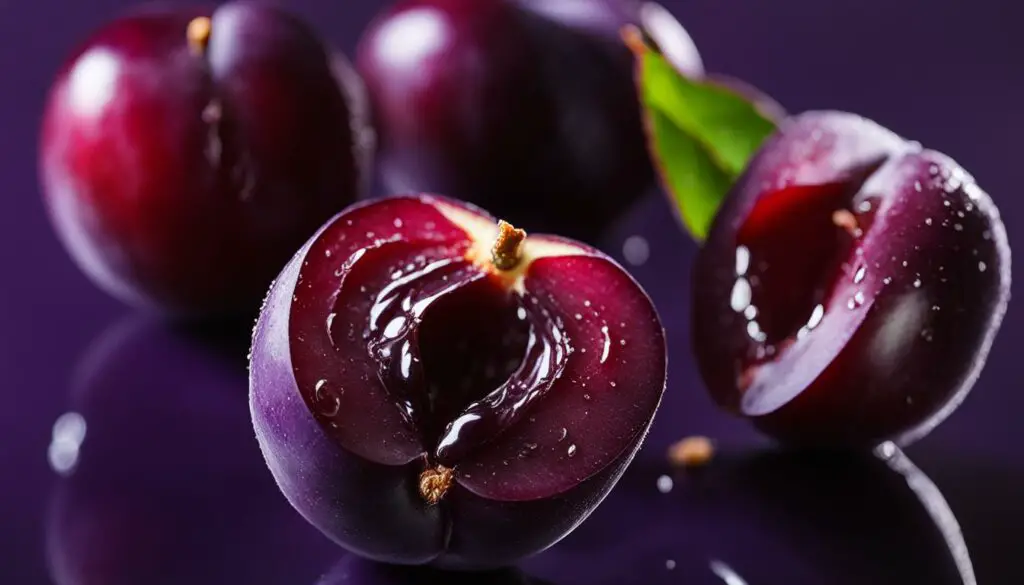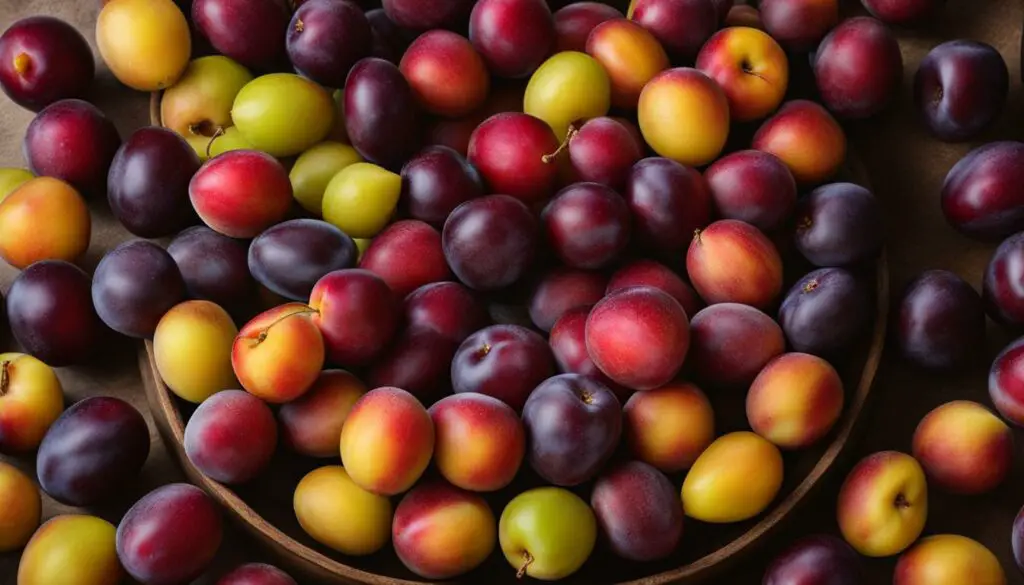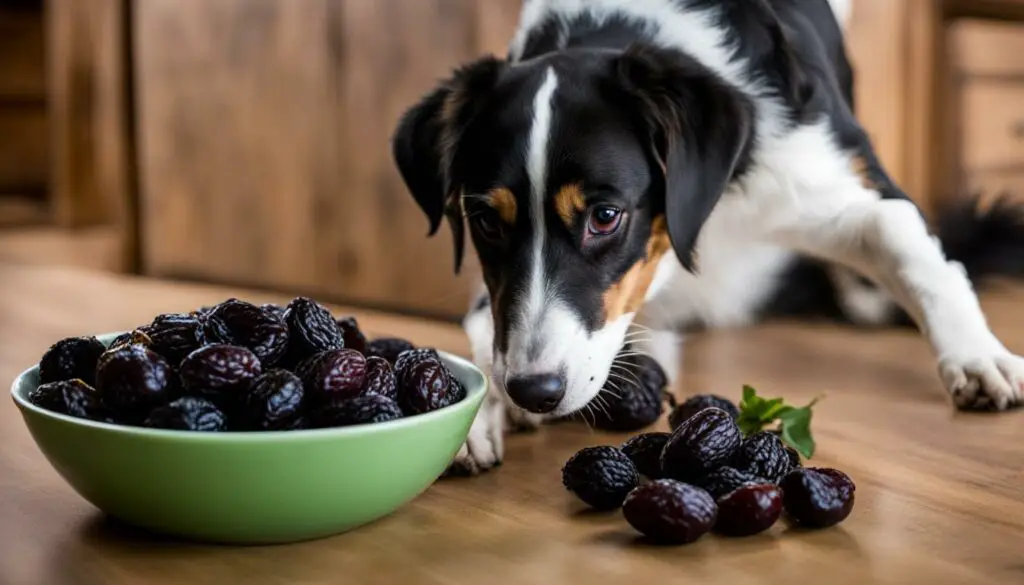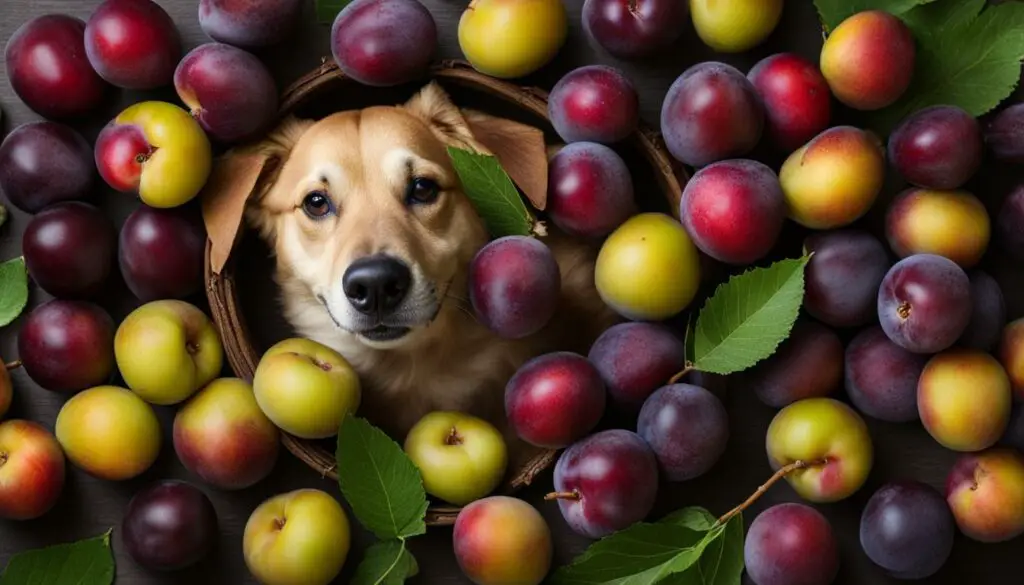As a responsible dog owner, it’s important to be mindful of what we feed our furry companions. While plums may seem like a tasty and nutritious treat, it’s crucial to understand the potential risks they pose to our dogs. In this article, I will explore whether dogs can safely eat plums and provide expert insights on how to navigate your pet’s diet to keep them safe and healthy.
Key Takeaways:
- Plums should not be included in a dog’s diet due to the cyanide content in the pits.
- The flesh of plums can be safe for dogs when precautions are taken to prevent them from consuming the pits.
- Immediate veterinary assistance is crucial if a dog has ingested a whole plum with the pit or chewed on the pit.
- Grapes and raisins pose different risks to dogs, such as potential kidney failure.
- To prevent dogs from eating plums, store them in a secure location, dispose of pits promptly, and provide outdoor supervision.
Why Are Plums Bad for Dogs?
When it comes to dogs and plums, there are several reasons why these fruits are considered bad for our furry friends. One of the main concerns is the potential for cyanide poisoning. Plum pits contain amygdalin, a chemical that can convert into cyanide when chewed. Ingesting the pit can lead to serious health issues for dogs, including cyanide poisoning. This is why it’s crucial to prevent them from consuming the pits.

Furthermore, plum pits pose a choking hazard to dogs. These pits are small enough to become lodged in a dog’s throat or digestive tract, causing blockages that may require surgical intervention. Ingesting plum pits can also cause digestive damage, leading to discomfort and potential complications for your pet. It’s important to be vigilant and keep plums and their pits out of your dog’s reach.
Another aspect to consider is the high sugar content in plums. While the flesh of plums is generally safe for dogs to consume in moderation, the high sugar content can have negative effects on their health. Excessive sugar intake can lead to upset stomach, obesity, and even diabetes in dogs. It’s essential to prioritize your dog’s well-being and opt for healthier alternatives.
Why Are Plums Bad for Dogs?
“Plum pits contain amygdalin, a chemical that can convert into cyanide when chewed.”
| Risks | Implications |
|---|---|
| Cyanide Poisoning | Ingesting the plum pit can result in cyanide poisoning for dogs. |
| Choking Hazard | The small size of plum pits can cause choking and require surgical intervention. |
| Digestive Damage | Ingesting plum pits can lead to digestive complications and discomfort for dogs. |
| High Sugar Content | Excessive sugar intake from plums can lead to upset stomach, obesity, and diabetes. |
To ensure the safety of our canine companions, it’s best to avoid feeding them plums altogether. Instead, opt for dog-safe fruits such as blueberries or bananas as a healthier alternative. By prioritizing their well-being and making informed choices about their diet, we can help keep our dogs happy and healthy.
My Dog Ate a Plum–What Do I Do?
If your dog has ingested a plum, it is important to take immediate action to ensure their safety. Plum poisoning can be a serious concern, and recognizing the signs of plum poisoning is crucial in determining the next steps. Some common signs of plum poisoning in dogs include difficulty breathing, red gums, dilated pupils, loss of appetite, panting, drooling, watery eyes, vomiting, tremors, and shock. If you notice any of these symptoms in your dog after consuming a plum, it is essential to seek veterinary assistance right away.
When contacting your veterinarian, provide detailed information about your dog’s symptoms and the quantity of plum ingested. This will help them assess the severity of the situation and provide appropriate guidance for treatment. It is important to note that plum pits pose a significant risk to dogs, so if your dog has chewed on or ingested the pit, special attention should be given to potential breathing difficulties or choking hazards.
While awaiting veterinary assistance, it may be helpful to keep your dog calm and in a quiet, comfortable environment. Avoid inducing vomiting without consulting a professional, as it may worsen the situation depending on the circumstances. Remember, prompt veterinary care is key when dealing with plum poisoning or any potential health concerns related to your dog’s diet.

Table: Signs of Plum Poisoning in Dogs
| Signs of Plum Poisoning in Dogs |
|---|
| Difficulty breathing |
| Red gums |
| Dilated pupils |
| Loss of appetite |
| Panting |
| Drooling |
| Watery eyes |
| Vomiting |
| Tremors |
| Shock |
Are Plums as Dangerous as Grapes and Raisins?
When it comes to discussing the dangers of certain fruits for dogs, plums often come up alongside grapes and raisins. While plums do pose their own risks, they are not as dangerous as grapes and raisins, which can lead to kidney failure in dogs. However, it is important to understand the specific hazards associated with each fruit to ensure the safety of your furry friend.
Plums, particularly their pits, contain amygdalin, a chemical compound that can be converted into cyanide when chewed. Cyanide poisoning can occur if a dog consumes the pit or chews on it, leading to serious health consequences. On the other hand, grapes and raisins contain toxins that can cause kidney failure in dogs, even in small amounts.
While both plums and grapes/raisins should be kept away from dogs, it is essential to note that ingesting plum pits is not the same as ingesting grapes or raisins. The risks associated with each fruit are different, and it is crucial to be aware of these distinctions to protect your pet’s health.
| Plums | Grapes/Raisins | |
|---|---|---|
| Toxicity Levels | Moderate | High |
| Main Health Concern | Cyanide poisoning | Kidney failure |
| Visible Symptoms | Difficulty breathing, red gums, dilated pupils, loss of appetite, panting, drooling, watery eyes, vomiting, tremors, shock | Vomiting, diarrhea, abdominal pain, lethargy, increased thirst, decreased urine production |
| Treatment | Immediate veterinary assistance | Immediate veterinary assistance |
Despite the differences, it is best to play it safe and keep all fruits, including plums, grapes, and raisins, away from your furry companion. By doing so, you can reduce the risk of potential harm and ensure that your dog’s diet remains safe and healthy.
How Do I Prevent My Dog from Eating Plums?
Pet safety is a top priority when it comes to keeping our furry friends healthy and happy. To prevent dogs from eating plums and potentially encountering the dangers associated with plum pits, there are several steps you can take.
First and foremost, it’s important to store plums in a secure location that is out of your dog’s reach. Plums should be kept in a closed cupboard or refrigerator where your dog cannot access them. This will help to prevent accidental ingestion of plum pits, which can be a choking hazard and lead to digestive damage.
In addition to proper plum storage, it’s crucial to dispose of plum pits promptly. Ensure that any discarded pits are placed in a sealed trash bag or container that is inaccessible to your dog. This will prevent them from being tempted to explore and potentially ingest the pits.
Training your dog with the “leave it” command can also be an effective strategy in preventing them from eating plums. By teaching your dog to leave the plum alone when commanded, you can reinforce their understanding that plums are off-limits. Consistency is key in reinforcing this command, so continue to practice “leave it” in various situations to ensure your dog’s safety.
When your dog is outdoors, it’s important to supervise them to prevent them from eating fallen plums. Keep an eye on your dog and promptly remove any plums they may come across. Outdoor supervision is particularly important during plum season when there may be an increased likelihood of finding fallen fruit.

Table: Plum Storage Tips
| Tip | Description |
|---|---|
| Store plums in a secure location | Keep plums in a closed cupboard or refrigerator |
| Dispose of plum pits promptly | Place discarded pits in a sealed trash bag or container |
| Train your dog with the “leave it” command | Teach your dog to leave plums alone when commanded |
| Supervise your dog outdoors | Remove any fallen plums to prevent your dog from eating them |
By following these precautions and implementing pet safety measures, you can help ensure that your dog stays safe and avoids the potential risks associated with eating plums. Remember, there are plenty of dog-safe alternatives to plums that you can explore to provide your furry companion with tasty and healthy snacks.
Can Dogs Have a Little Bit of Plum?
While it is generally safer to avoid feeding plums to dogs altogether, there may be instances where you are considering giving your furry friend a small amount of plum. When it comes to feeding dogs any human food, moderation and caution are key. It is essential to remember that the pit of the plum can be hazardous and potentially fatal if ingested by your dog.
Feeding your dog a small quantity of plum flesh without the pit can be considered relatively safe. However, it is crucial to monitor your dog for any signs of digestive discomfort, such as upset stomach or diarrhea. Every dog’s tolerance and reaction to different foods can vary, so it is important to introduce new foods gradually and in small quantities to observe any adverse effects.
Instead of offering plums to your dog, there are alternative fruits that you can safely incorporate into their diet. Blueberries, for example, are packed with antioxidants and are generally well-tolerated by dogs. Bananas are another fruit that dogs can enjoy in moderation. Just remember to remove any seeds or pits from the fruit before offering it to your furry friend to ensure their safety.
| Fruit | Benefits |
|---|---|
| Plums | Contain fiber, vitamins, antioxidants |
| Blueberries | High in antioxidants, low in calories |
| Bananas | Good source of potassium, easily digestible |
Remember, when considering adding any new food to your dog’s diet, it is always best to consult with your veterinarian to ensure it is safe and appropriate for your specific furry friend.

Can Dogs Have Purple Plums?
When it comes to the color of plums, whether they are purple, red, or yellow, all plums pose the same risks for dogs. It’s important to understand that the danger lies in the pits found in plums, which can be harmful if ingested. The cyanide content in the pits can lead to poisoning in dogs, making all plums hazardous. Therefore, it is crucial to prevent dogs from consuming any type of plum, regardless of its color.
The pit danger applies to all varieties of plums, whether they are Japanese plums, yellow plums, red plums, or black plums. While the flesh and skin of plums may not be toxic to dogs, the pits present a choking hazard and can cause digestive damage. To ensure the safety of your furry friend, it’s best to remove the pits from plums before giving them to your dog.
While the temptation to share a juicy, colorful plum with your dog may be strong, it’s essential to prioritize their well-being. Avoiding plums altogether is the safest choice to prevent any potential harm to your canine companion. Instead, consider offering dog-safe alternatives like blueberries and bananas, which are both delicious and beneficial for your dog’s health.

| Table: Risks Associated with Plum Color | |
|---|---|
| Pit Danger | All plums, regardless of color, have pits that can be harmful if ingested. |
| Hazardous Plum Varieties | Japanese plums, yellow plums, red plums, and black plums all contain pits that pose a danger to dogs. |
| Safe Alternatives | Opt for dog-safe fruits like blueberries and bananas instead of plums. |
What Type of Plum is Best for Dogs?
When it comes to choosing a safe and suitable plum variety for your furry friend, it’s important to note that no plum is truly safe for dogs. All types of plums, including Japanese plums, yellow plums, red plums, and black plums, pose the same risks due to the presence of pits and potential cyanide poisoning. While the flesh and skin of plums are generally safe for dogs to consume in moderation, it’s best to err on the side of caution and avoid feeding plums to your canine companion altogether.
Plum pits contain amygdalin, a chemical that can convert into cyanide when chewed. Ingesting the pit can lead to cyanide poisoning in dogs, causing serious health complications. Additionally, the pits can pose a choking hazard and potentially cause digestive damage. To keep your dog safe, it’s crucial to remove the pits before offering any plum flesh or avoid feeding plums entirely.
If you’re looking for alternative fruits to incorporate into your dog’s diet, consider dog-safe options such as blueberries and bananas. These fruits provide similar nutritional benefits without the associated risks. Remember to always introduce new foods gradually and in moderation, keeping a close eye on your dog’s reaction and overall well-being.

Safe Plum Varieties for Dogs:
| Plum Variety | Risk Level |
|---|---|
| Japanese Plums | High risk due to pit content |
| Yellow Plums | High risk due to pit content |
| Red Plums | High risk due to pit content |
| Black Plums | High risk due to pit content |
The table above summarizes the risk level associated with different plum varieties for dogs. Regardless of the type of plum, it’s crucial to prioritize your dog’s safety and well-being by avoiding the consumption of plums altogether.
When Can I Give My Dog a Plum?
While it may be tempting to share a juicy plum with your furry friend, it’s important to understand the potential risks involved. Giving your dog a plum can pose several dangers, including the risk of cyanide poisoning from the pit and potential digestive issues due to the high sugar content. Therefore, it is not recommended to give your dog a plum at any time.
The cyanide content in the pit of a plum can cause serious harm to your dog if ingested. Dogs may be attracted to the pit due to its small size and chew it, leading to cyanide poisoning. Symptoms of cyanide poisoning include difficulty breathing, drooling, vomiting, and tremors. In severe cases, it can even be fatal. To keep your dog safe, it is best to avoid giving them plums altogether.
Additionally, the high sugar content in plums can cause digestive issues such as upset stomach, diarrhea, and even weight gain. Dogs have different nutritional needs than humans, and feeding them foods high in sugar can lead to long-term health problems. It’s always best to consult with your veterinarian for appropriate and safe food choices for your furry friend.

Expert Quote:
“Plums may seem like a healthy and refreshing treat for dogs, but the potential risks associated with the cyanide content in the pit and high sugar levels make them unsafe for canine consumption. It’s best to err on the side of caution and avoid giving your dog plums altogether.” – Dr. Alex Schechter, DVM
Can Dogs Eat Prunes?
Feeding dogs prunes, which are dried plums, is not recommended. Prunes are known for their high sugar and fiber levels, which can potentially cause stomach upset, weight gain, vomiting, diarrhea, and loss of appetite in dogs. While prunes may be a tasty treat for humans, they are not suitable for canine consumption.
It is important to prioritize your dog’s health and well-being when considering their diet. The high sugar content in prunes can lead to various health issues in dogs, including gastrointestinal discomfort and weight gain. Additionally, the high fiber levels in prunes can have a laxative effect on dogs, causing digestive upset.
To ensure your dog’s dietary needs are met, it is best to stick to dog-approved treats and foods. Consult with your veterinarian for guidance on appropriate snacks and fruits for your furry friend. There are many alternative fruits that are safe for dogs to enjoy in moderation, such as blueberries and bananas, which provide various health benefits without the potential risks associated with prunes.

Table: Comparison of Plum and Prune Nutritional Values
| Component | Plum (100g) | Prune (100g) |
|---|---|---|
| Calories | 46 | 240 |
| Sugar | 9.9g | 38g |
| Fiber | 1.4g | 7.1g |
| Vitamin C | 6.4mg | 0.6mg |
| Vitamin A | 345IU | 23IU |
The table above showcases a comparison of the nutritional values between plums and prunes. While plums contain fewer calories, less sugar, and higher amounts of vitamins, prunes have significantly higher calorie and sugar content, along with increased fiber levels. It is essential to consider these differences when choosing suitable fruits for your dog’s diet.
Dogs and Plums: Potential Benefits
When it comes to the topic of dogs and plums, there may be some potential benefits that can be derived from including this fruit in your pet’s diet. Although plums should be given in moderation and with certain precautions, they do offer a few advantages for your furry companion’s overall well-being.
One notable benefit of plums is their high fiber content, which can aid in digestion. Fiber plays a crucial role in maintaining a healthy digestive system for dogs, promoting regular bowel movements and preventing constipation. Additionally, plums contain essential vitamins that contribute to your dog’s overall health. These vitamins include vitamin A, which supports eye health, and vitamin C, which boosts the immune system and helps fight off diseases.
Another advantage of plums is their antioxidant properties. Antioxidants, such as those found in plums, help protect the body’s cells from damage caused by harmful free radicals. This can help boost your dog’s immune system and reduce the risk of developing certain diseases. Moreover, plums are relatively low in calories and fat, making them a healthy option for dogs who need to maintain a balanced weight or manage weight loss. Lastly, plums contain minerals like potassium, which is important for maintaining healthy bones in dogs.
| Benefits of Plums for Dogs | Keywords |
|---|---|
| High fiber content | fiber for digestion |
| Essential vitamins | vitamins for health |
| Antioxidant properties | antioxidants for immune system |
| Low in calories and fat | low in calories and fat |
| Minerals for bone health | bone health |
While there are potential benefits to feeding plums to dogs, it’s crucial to exercise caution and moderation. Always remove the pits, as they can be a choking hazard and contain cyanide, which is toxic to dogs. Additionally, it’s essential to introduce new foods gradually and monitor your dog for any adverse reactions. Consulting with your veterinarian is always recommended before making any significant changes to your pet’s diet.
Remember, while plums offer some advantages for dogs, there are alternative fruits that can provide similar benefits without the associated risks. Blueberries and bananas, for example, are safe options that can offer comparable nutritional value. Ultimately, the well-being and safety of your furry friend should always be the top priority when it comes to their diet and nutrition.
Types of Plums for Dogs
Dogs can safely enjoy certain varieties of plums in moderation. Although plums should generally be avoided due to the risks associated with the pits, there are some safe options for your furry friend. Japanese plums, yellow plums, red plums, and black plums can be given to dogs as long as the pits are removed to prevent any potential choking hazards.
Japanese plums, also known as Prunus salicina, are a popular choice for dogs. They have a firm texture and a sweet, juicy flavor that dogs may find appealing. Yellow plums, such as the Golden Nectar and Golden Sweet varieties, can also be a safe option for dogs. These plums have a milder flavor and are less acidic compared to other varieties.
Red plums, such as the Santa Rosa and Burgundy varieties, can be enjoyed by dogs as well. These plums have a vibrant red color and a tart yet sweet taste. Lastly, black plums, such as the Black Amber and Black Ruby varieties, can also be included in your dog’s diet. These plums have a rich, dark skin and a sweet flavor.
It is important to note that while these plum varieties are safe for dogs to consume, moderation is key. Too much plum intake can still lead to digestive issues and potential health problems. Always consult with your veterinarian before introducing any new foods to your dog’s diet.

| Plum Variety | Description |
|---|---|
| Japanese Plums | Firm texture, sweet, juicy flavor |
| Yellow Plums | Milder flavor, less acidic |
| Red Plums | Vibrant red color, tart yet sweet taste |
| Black Plums | Rich, dark skin, sweet flavor |
Conclusion
After examining the risks and potential benefits, it is clear that plums should not be a part of a dog’s diet. The cyanide content in plum pits and the potential for choking hazards make them unsafe for our furry friends. While the flesh of plums is generally safe, it is better to err on the side of caution and avoid feeding plums to dogs altogether.
When it comes to keeping our pets healthy, there are safer alternatives to consider. Blueberries and bananas, for example, are dog-safe fruits that can be given in moderation. It is also important to store plums in a secure location and promptly dispose of any pits to prevent accidental ingestion.
Remember, the well-being of our dogs should always be a top priority. By making informed choices about their diet and ensuring they receive the necessary nutrients from other sources, we can keep them happy and healthy for years to come.
In summary, plums pose potential risks to dogs, and the safest choice is to avoid feeding them to our furry companions. Choose alternative fruits, store plums safely, and prioritize your dog’s health to ensure a long and fulfilling life together.
FAQ
Can dogs eat plums?
While the flesh of plums is generally safe for dogs, precautions should be taken to prevent them from consuming the pits, which can be dangerous and potentially fatal due to the cyanide content.
Why are plums bad for dogs?
Plum pits contain amygdalin, a chemical that converts into cyanide when chewed. Ingesting the pit can lead to cyanide poisoning in dogs. Plum pits are also a choking hazard and can cause digestive damage. The high sugar content in plums can also lead to health issues like upset stomach, obesity, and diabetes in dogs.
My dog ate a plum–what do I do?
Immediate veterinary assistance is crucial if a dog has ingested a whole plum with the pit or chewed on the pit. Signs of plum poisoning include difficulty breathing, red gums, dilated pupils, loss of appetite, panting, drooling, watery eyes, vomiting, tremors, and shock. It is important to determine if the pit was swallowed whole or chewed on and seek appropriate medical care.
Are plums as dangerous as grapes and raisins?
Grapes and raisins can lead to potentially fatal kidney failure in dogs, while plums can cause cyanide poisoning and digestive issues. Both plums and grapes or raisins should be kept out of reach from dogs to prevent any harm.
How do I prevent my dog from eating plums?
To prevent dogs from eating plums, store them in a secure location out of the dog’s reach. Dispose of plum pits promptly and teach the dog the “leave it” command. Outdoor supervision is necessary to prevent dogs from eating fallen plums. Dog-safe alternatives can also be considered.
Can dogs have a little bit of plum?
While the flesh and skin of plums are not toxic to dogs, it is generally safer to avoid feeding plums to dogs altogether. Other dog-safe fruits like blueberries and bananas can be given in moderation instead.
Can dogs have purple plums?
Regardless of the color, all plums contain pits that can be harmful if ingested. The risks associated with plums are due to the pit and potential cyanide poisoning, not the color of the fruit.
What type of plum is best for dogs?
No plum variety is truly safe or recommended for dogs. All types of plums pose the same risks due to the presence of pits and potential cyanide poisoning.
When can I give my dog a plum?
It is not recommended to give a dog a plum at any time due to the potential risks associated with the pit and high sugar content. Avoiding plums altogether is the safest choice for a dog’s well-being.
Can dogs eat prunes?
Feeding dogs prunes, which are dried plums, is not recommended. Prunes are high in sugar and fiber levels, which can cause stomach upset, weight gain, vomiting, diarrhea, and loss of appetite in dogs.
Dogs and plums: Potential benefits
Plums can provide benefits to dogs when consumed in moderation. They contain fiber for digestion, essential vitamins for overall health, antioxidants for the immune system, low calories and fat for weight management, and minerals for bone health.
What types of plums are safe for dogs?
Japanese plums, yellow plums, red plums, and black plums can be given to dogs, but pits should be removed to prevent choking hazards. However, it is generally best to avoid feeding plums to dogs altogether.
Can dogs have plums in moderation?
Plums are generally not recommended for dogs due to their pits’ cyanide content and potential choking hazards. While the flesh of plums is safe in moderation, there are safer alternatives and precautions to consider for your dog’s diet. Always prioritize your dog’s health and well-being when choosing their food.
Can dogs eat plums? Is it safe for them?
While the flesh of plums is generally safe for dogs, it is important to remember the risks associated with the pits and the high sugar content. It is best to avoid feeding plums to dogs altogether and opt for dog-safe alternatives.
Can dogs eat plums if they are purple?
The color of the plum does not change its risks for dogs. Whether purple, red, or yellow, all plums contain pits that can be harmful if ingested. It is important to prevent dogs from consuming any plum pits.
Can dogs eat plums occasionally?
While plums may have potential benefits for dogs, it is generally best to avoid feeding plums to dogs altogether. Other fruits like blueberries and bananas can provide similar benefits without the risks associated with plums.
Can dogs eat plums if they have been pitted?
While removing the pits can reduce the choking hazard, plums should still be avoided for dogs due to their high sugar content and potential digestive issues. It is best to opt for safer alternatives for your dog’s diet.
Are plums toxic to dogs?
The flesh of plums is generally safe for dogs, but precautions should be taken to prevent them from consuming the pits, which can be dangerous and potentially fatal due to the cyanide content. It is best to avoid feeding plums to dogs altogether.
Source Links
- https://be.chewy.com/nutrition-pet-diet-tips-can-dogs-eat-plums/
- https://dogchild.co/en-us/blogs/learn/can-dogs-eat-plums-can-dogs-have-plums-everything-you-need-to-know-about-feeding-you-dog-plums
- https://www.dailypaws.com/dogs-puppies/dog-nutrition/what-can-dogs-eat/can-dogs-eat-plums







